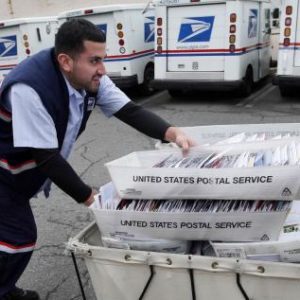Speaker Nancy Pelosi is leading the House of Representatives into a special session Saturday to address the U.S. Postal Service.
This despite the fact that — under intense scrutiny — Postmaster General Louis DeJoy reversed changes that were said to be slowing mail ahead of the November election.
Even if Pelosi gets her wish and the measure is signed into law promptly, America’s mail system has unacceptable problems that need a fuller examination.
It simply takes too long for first-class mail, which is how all voting mail should be sent, to be delivered. The quality of mail service has deteriorated over the past decade as the Postal Service puts more of its time and effort on packages.
Regarding the 2018 election, the Postal Service’s Office of Inspector General reported that election mail “is generally First-Class Mail and its service standard ranges from 1-3 days.” Yet, the goal for getting this important mail delivered on time was met 95.6 percent of the time, below the 96 percent standard for the Postal Service.
Having 96 percent odds of winning in Vegas sounds great. Having only a 96 percent chance of surviving an airplane flight does not.
With millions of mail-in ballots in toss-up states, the Postal Service’s less than 96 percent success rate should concern all Americans who treat voting as a sacred duty and want to make sure their vote counts. The Postal Service’s delivery standards underscore the benefits of in-person voting.
If one must vote by mail, better to drop off the ballot in person at a designated facility.
Today, it takes 27 percent longer to deliver first-class mail than it did in 2014. For 2014, USPS reported “first-class mail was delivered in an average of 1.8 days.” On August 7, the Postal Service announced first-class mail took an average of 2.3 days to be delivered for the quarter that ended June 30, and in the like quarter a year earlier.
The Postal Service was supposed to meet the 96 percent threshold for first-class mail delivery starting in Fiscal Year 2014. It never has. Numerous reports since then from the Postal Service and its regulator, the Postal Regulatory Commission, are quite troubling.
— On March 25, the PRC said, “The Commission reports that most products failed to meet their service performance targets in FY 2019. For the fifth consecutive year, no first-class mail product category achieved its service performance target.”
— Productivity has fallen each of the last four years at USPS, a cumulative decline of 4.7 percent, the Postal Service said in its Fiscal Year 2019 Annual Report to Congress.
— For Fiscal Year 2015, when USPS productivity was significantly higher than it is today, the PRC stated it was “particularly concerned with the recent dramatic decline of service performance for first-class mail.”
The chronic failure to meet first-class mail standards has correlated with a dramatic rise in package delivery. From fiscal year 2015 to 2019, first-class mail volume dropped 12 percent while shipping and package volume rose 36 percent.
For much of the last 10 years, with mail volume declining, there has been far more infrastructure available to facilitate mail delivery than needed. And yet, delivery targets were consistently not met.
By law, the Postal Service is to prioritize mail delivery over package delivery. If the Postal Service has in fact prioritized packages over the mail, the new Postmaster General needs to root this out.
Furthermore, a $25 billion or so cash infusion to the Postal Service will not solve the mail delivery service shortfall and could make things worse.
The Postal Service already has ample cash on hand — $12.9 billion and the ability to borrow $10 billion more. A $25 billion infusion is likely to primarily benefit large e-commerce companies shipping packages, while distracting from the re-engineering and process assessments that would improve mail delivery.
The benefits of prompt and reliable first-class mail delivery are potentially huge for the Postal Service. It will help it retain more of its most profitable service.
While materially improving mail quality by Election Day is overly ambitious, it needs to happen as soon as possible. America will benefit from this change.
Congress should make improved delivery times a central part of overdue holistic postal reform legislation.

